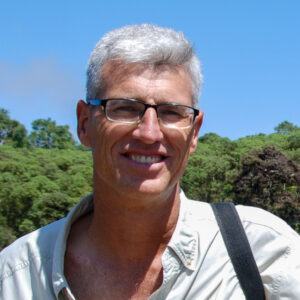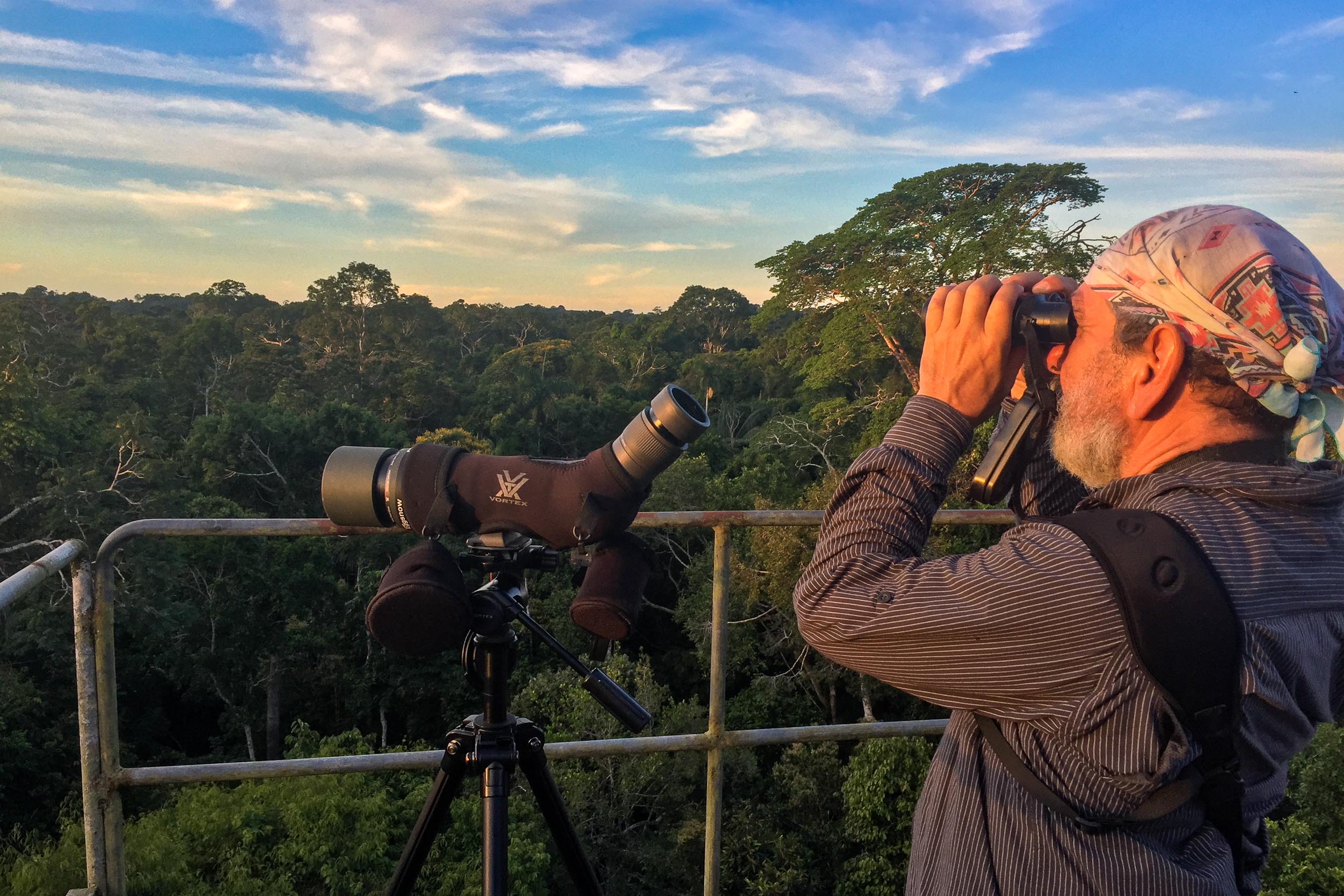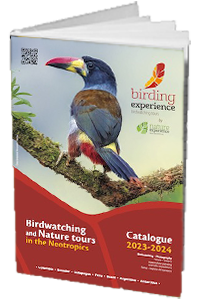Your travel expert
Xavier Amigo
Responsible for naturalist, botanical and ornithological travel. Responsible of fixing and professional contact.

You won't find this Galapagos cruise anywhere else! Birding Experience has designed this tour especially for birding enthusiasts to discover as many endemic species as possible in the Galapagos. So, set sail in Darwin's footsteps in search of the world's unique wildlife!
Our expert birders have meticulously designed this unique short birdwatching cruise to optimize the sighting of almost all the birds on the Galapagos islands. The Galapagos National Park has authorized our tour to adapt the standard boat routes, allowing us to visit all the key birding locations, including the remote northern islands of Darwin and Wolf, in search of the rare Vampire Finch. Crossing the vast maritime expanses of the northern archipelago will also allow us to look for a large number of pelagic bird species.
Your travel expert
Xavier Amigo
Responsible for naturalist, botanical and ornithological travel. Responsible of fixing and professional contact.

Arrival at Mariscal Sucre International Airport in the Ecuadorian capital at the end of the day. Welcome, transfer, and short briefing about the upcoming trip. Depending on the flight schedule, we can stroll around our hotel to see some of the typical species of the inter-Andean valley.
Dinner and overnight stay in a standard hotel in the inter-Andean valley near the airport.
Private transfer, English-speaking assistance and overnight.
Sparkling Violetear, Black-tailed Trainbearer, Giant Hummingbird, Western Emerald, Great Thrush, Saffron Finch, Scrub Tanager, Blue and Yellow Tanager
Morning transfer from your hotel to Quito National Airport, accompanied by one of our team, for your flight to the Galapagos Archipelago. Upon arrival at Baltra, the archipelago’s main airport, a health and environmental inspection is conducted to protect these fragile ecosystems from exogenous intrusion. Your naturalist guide will be waiting for you at the airport. You will go with him to the pier where your yacht is anchored. You will be welcomed on board by the entire crew and the captain, who will give you a quick welcome briefing and help you get to your cabins and familiarize yourself with the different areas of the ship. In the afternoon, we will set sail for Seymour Island. Blue-footed Boobies, Brown Noddys and Galapagos Shearwaters will accompany you during these first hours of sailing. Seymour Island is home to a large colony of Sea Lions, both species of Frigatebirds and the endemic Swallow-tailed Gull. The short trail will also take you through the Palo Santo trees (Brusera) and Opuntia cactus vegetation.
Private transfer with English-speaking assistance to the airport, English-speaking naturalist guide onboard and overnight.
Brown Pelican, Magnificent Frigatebird, Great Frigatebird, American Oystercatcher, Red-billed Tropicbird, Swallow-tailed Gull, Blue-footed Booby, Red-footed Booby, Nazca Booby, Brown Noddy, Galápagos Shearwater, Lava Gull, Small Tree Finch
Darwin and Wolf are the northernmost islands of the archipelago. They are part of a different geological era and origin from the rest of the Galapagos. The first great attraction of this island is for divers, the presence of one of the largest biomasses of underwater species and in particular of large sharks, including the whale shark and the scalloped hammerhead shark. But for scientists and birdwatchers, the Vampire Ground-Finch is the star of the place. It is the last species of its kind described by science in the Galápagos. Genetically separated from the Sharp-beaked Ground-Finch, it is the 17th species of Darwin's finches to be found on the archipelago. This new taxon has adapted to the seasonal lack of seeds by turning to a hematophagous (blood) diet in times of shortage. Yes, this insignificant little bird supplements its diet, as its name suggests, by absorbing blood, by pecking the skin of fools, and then sucking the wound and feeding on its hemoglobin. Thanks to the zodiac, we will go along the different areas of the island to try to observe this rare bird.
English-speaking naturalist guide
Galápagos Shearwater, Vampire Ground-Finch, Galápagos Petrel, Galápagos Shearwater, White-vented Storm-Petrel, Galápagos Storm-Petrel, Galapagos Martin, Red-footed Booby.
Even further north is Darwin. A true pelagic sanctuary, this small island is bathed in the warmest waters of the archipelago. Due to its isolation, it is home to the largest colonies of Red-footed Boobies and Nazca Boobies in the archipelago. In addition to another population of Vampire Ground-Finch, the micro endemic subspecies of the Galapagos Dove, darker than that of the central islands, can also be found here. Many pelagic and semi-pelagic birds also have a nesting place here. During migration, many shorebirds choose this island as a temporary stopover. We will explore the steep coastline of the island by sea in our zodiacs. the same as on Wolf Island, it is strictly forbidden to land on these islands. In the afternoon we start our long sail south to the central islands. The upper deck will provide an excellent platform for further sea-watching.
English-speaking naturalist guide
Key species: Galápagos Dove, Red-footed Booby, Nazca Booby, Galápagos Warbler (ssp.) Galápagos Mockingbird (ssp), Vampire Ground-Finch, Large Ground-Finch (ssp.), Red-billed Tropicbird, White-vented Storm-petrel, Markam’s Storm Petrel, Sooty Shearwater, Lava Heron, Magnificent Frigatebird, Pink-footed Shearwater, Brown Noddy, Swallow-tailed Gull, Sooty Tern, Elegant Tern.
Genovesa Island, in the north-west of the archipelago, is essentially made up of the remains of a huge crater, now largely submerged. Nicknamed "Bird Island", its reputation is well deserved. On the coral sands of Darwin Bay, many species nest on the ground or in the scrub. Along the trails, you can also see many of the island's endemics. A panga ride along the cliffs of the submerged volcano will allow you to observe the amazing gliders that are the seabirds and, in particular, the Red-Billed Tropicbird, that plays in the air currents created by the cliffs. Walking along the cliff path, you can see many species of pelagic and semi-pelagic birds, as well as 4 of the 14 species of Darwin's Finches. In the afternoon, a visit to El Barranco will allow us to learn about the geological and volcanic past of the archipelago, through the prism of the numerous "pa-hoe-hoe" lava fields.
English-speaking naturalist guide
Short-eared Owl, Gray Warbler-Finch, Large Ground-Finch, Genovesa Ground-Finch, Genovesa Cactus-Finch,
Genovesa Mockingbird, Red-Billed Tropicbird, Nazca Booby, Red-footed Booby, Band-rumped Storm Petrel, Wedge-rumped Storm Petrel, Galápagos Shearwater, American Oystercatcher, Lava Gull, Red Phalarope, Warbler Finch, Large Ground Finch, Galapagos Flycatcher, Galápagos Dove, Swallow-tailed Gull.
We will wake up this morning at the northernmost point of San Cristobal Island. Punta Pitt is reached via a yellow sandy bay, where it is common to see many shorebirds. The path that climbs to the top of the cliffs provides good opportunities to see and photograph a large number of finches and other passerines. On the higher ground, several colonies of boobies await us as well as frigate birds and other marine species. We will then walk along the east coast of the island to the islet Lobos. Here we will be able to observe a spectacular panoramic landscape, as well as dense Opuntia forests, where Mockingbirds, Finches and large colonies of Frigatebirds, but also numerous marine iguanas, nest. This will be an excellent time to talk about history and Charles Darwin's first landing in the Galapagos.
English-speaking naturalist guide
Red-billed Tropicbird, Elliot's Storm-Petrel, Galapagos Hawk, Wedge-rumped Storm-Petrel, Galapagos Shearwater, Wandering Tattler, Swallow-tailed Gull, Brown Noddy, American Oystecatcher, Waved Albatros, Galapagos Petrel, Blue-footed, Red-footed and Nazca Booby, San Cristobal Mockingbird, Common Cactus-Finch, Medium Ground-Finch, Gray Warbler-Finch, Small Tree-Finch, Galapagos Flycatcher.
Española is the southernmost island of the archipelago and also one of the oldest. Its geographical isolation has led to the appearance of several endemic species. You will have to keep your eyes wide open to try to observe the Española Mockingbird or the local Giant Land Turtle species. The latter is a true miracle, as the population has grown from 14 survivors in 1960 to more than 2000 individuals today. But the star of the site is without doubt the Galapagos Albatross. From April to December, couples raise their young here. The love dance of these winged giants, made up of beak snapping and head bobbing, is particularly rhythmic, but without any arguments! In the afternoon you will go to a snorkeling site for a water walk in the company of schools of Royal Damselfish, Humphead Parrotfish and Galapagos Surgeonfish. An aquatic immersion that varies according to the time of year and the sea currents.
English-speaking naturalist guide
Waved Albatros, Lava Heron, Red-necked Phalarope, White-cheeked Pintail, Yellow-crowned Night-Heron, Great Blue Heron, Ruddy Turnstone, Galápagos Hawk, Yellow-crowned Night-Heron, Purple Martin, Española Mockingbird, Masked Booby, Semipalmated Plover, Gray Warbler-Finch, Small Ground-Finch, Galapagos Petrel, Española Ground-Finch.
This morning we will wake up facing the northeast coast of Floreana Island, the southernmost of the archipelago. Floreana is home to two strictly endemic species, which we will look for in two very different locations. Firstly, from the port of Velasco Ibarra, we will go up to the Asilo de la Paz. This wooded hill is one of the best sites for the Medium Tree-Finch. But it is also the breeding ground for several species of giant tortoises. We will then return to our speedboat, and head for the Champion Islet, home to one of only two populations of the Floreana Mockingbird. During the sea crossing to the north, we will complete the day's observation with a search for pelagic birds and cetaceans.
English-speaking naturalist guide
Paint-billed Crake, Medium Tree-Finch, White-cheeked Pintail, Dark-billed Cuckoo, Yellow Warbler, Small Ground-Finch, Semipalmated Plover, Galapagos Flycatcher, Gray Warbler-Finch, Medium Ground-Finch, Magnificent Frigatebird, Great Blue Heron
From Puerto Ayora, we will go by private bus to the heights of Santa Cruz in order to look for typical species of different ecosystems, between original vegetation covers, agricultural areas and ecotones. We will focus on a habitat that we have not yet had the chance to visit (the miconia zone), in two particular sites: Media Luna and Cerro Crocker. It is here that we will try to observe our last endemic of the islands: the very rare and discreet Galapagos Rail. Around the secondary forests of Rancho Primicia we will complete our list with several typical highland passerines of this island. Late morning transfer to Baltra airport for our flight to Guayaquil, followed by our international flight.
English-speaking naturalist guide
Galápagos Rail, Paint-billed Crake, Galápagos Mockingbird, Galápagos Flycatcher, Galápagos Dove, Short-eared Owl, Green Warbler-Finch, Woodpecker Finch, Small Tree-Finch, Brujo Flycatcher, Vegetarian Finch, Small Ground-Finch, Medium Ground-Finch, Dark-billed Cuckoo, Large Tree-Finch, Large Ground-Finch, Common Cactus-Finch, Galapagos Barn Owl.
Dates of the next departures
If you wish to organize a cruise, either longer or on different dates, please contact us.
You want a personalized departure date? Contact us. Request a personalized date
| Dates | Itinerary | Status |
|---|---|---|
| From Jul 31 to Aug 08, 2025 | 8 day's Birdwatching Itinerary | Trip confirmed (10 places left) |
| From Jul 30 to Aug 07, 2026 | 8 day's Birdwatching Itinerary | Open to booking (12 places left) |
Prices per person
| Itinerary | Price lower deck |
|---|---|
| 8 day's Birdwatching Itinerary | 3,270 US$ |
You are a group of travelers and want a special rate? Contact us. Request a personalized quote
Included
Not included
Payment and reservation terms
To book your tour, please confirm your agreement in writing to the local agent.
The agency declines all responsibility for the execution of the confirmed services in case of non compliance with the above payment terms.
The rates quoted here are based on payment to our US account only.
Important note
This trip incorporates a special cruise itinerary, including unconventional sites for this ship. A special request to change the itinerary has been made to the Galapagos National Park. The itinerary is therefore subject to last minute changes, should the National Park not agree to this request. Changes may also occur as a result of natural disasters or changes in domestic legislation. The visitor must take into account and accept the possibility of last-minute changes in the organisation of the trip. The operator therefore reserves the right to make any changes necessary to ensure the safety and integrity of the travellers and to comply with the laws in force. The hotels are given as an indication subject to availability at the time of booking the tour. In case of unavailability, a hotel of the same category will be proposed.
Formalities
Formalities: Passport valid 6 months after your return date. No visa is required at this time. Your health insurance (private or public) is mandatory to enter Ecuador.
Vaccinations: Although no vaccinations are compulsory, we advise you to consider vaccinations against tetanus, yellow fever and hepatitis A and B as essential.
We recommend that you consult your doctor before departure and that you take out insurance to cover medical expenses and repatriation.
Concerning parasitic diseases transmitted by mosquito bites (such as malaria, dengue fever, Chikungunya) please note that Quito, the centre of the country and the Galapagos are not affected. Furthermore, the majority of the country's risk areas are not located in the areas we visit on our tours.
* In US dollars based on 8 participants in a double room/cabin. These rates are valid for the dates selected but may be subject to increase at the time of booking. Our quotations are calculated in US Dollars and we are committed to this amount. The equivalent value in Euros or in any other currency is therefore indicative and calculated on the basis of the exchange rate on the day of the offer.
**Flight prices are indicative and may change depending on the date of confirmation. The purchase of the tickets must be done by the ship owner for the whole group (8 pax)
Photo credits: Xavier Amigo, Dusan-Brinkhuizen, Pierre Ferron, Vincent Mouret.
Your guide for this trip

Luis Die



Born in Spain, he has been living in the Galapagos and Ecuador for 30 years, where he leads trips throughout the country. He studied biology at the Universidad Autonoma de Madrid where he also obtained a master's degree in ecology. He started birding at the age of 15 and since then it has been a passion for him wherever he travels. As a certified Galapagos naturalist guide with over 30 years of experience in the islands, he has led groups of travelers from all over the world, in Spanish, French or English, focusing on birding, wildlife, flora and marine life. He is an avid birder, hiker, cyclist and photographer, as well as a lecturer, and has a passion for sharing the natural world with others, not only in the Galapagos but also in the cloud forests and Amazon rainforest. As a guide, he has led groups in different countries in South America, Central America, Antarctica and Africa. Author of a field guide to the terrestrial life of the Galapagos (Vol 1) and the marine life of the Galapagos (Vol 2), published by Spot Fieldguides.
Nortada
The Nortada, a French-built boat, was completely refitted in 2014 and offers a distinctive liveaboard experience in the Galapagos. Measuring 26 meters, it features four small, air-conditioned cabins with bunk beds. It operates primarily for diving tours but also provides cruises focusing on naturalist observations. With a relatively small capacity catering to only 8-12 guests, it is perfect for birdwatchers, nature lovers, and photographers seeking a more intimate and personalized journey.
The Nortada holds a special permit from the Galapagos National Park, which authorizes it to navigate to the remote islands of Darwin and Wolf. These locations are renowned for their spectacular diving opportunities, but also allow close access to lagoons hosting some of the archipelago’s rarest species, such as the Sooty Tern and the endemic Vampire Finch, making the Nortada one of the few yachts permitted to explore these exclusive areas.
Category |
Superior category |
|---|---|
Construction |
1986 (France) - Rebuilt 2014 (Ecuador) - Fiberglass |
Length |
26 m / 85 ft |
Beam |
6 m / 20 ft |
Speed |
10 knots |
Capacity |
12 passengers |
Crew |
9 crew members plus 1 or 2 bilingual English-Spanish guide(s) |
Cabins |
4 cabins (triple) with bunk beds |
Motor |
2 CUMMINS 6CTA8.3-M 255 HP / 190 kW |
Electricity |
110V & 220V |
Internet |
No |
Facilities |
3 decks |
Security |
2,15 ft Nautica inflatable boats with 25 HP four stroke outboard engines |
Characteristics of the trip
Travel theme |
Galapagos Islands cruise, ornithological, naturalist and photographic |
|---|---|
Accompaniment |
Bilingual naturalist guide |
Group |
8-12 passengers |
Arrival city |
Quito |
Departure city |
Quito |
Food |
Local and family cuisine |
Accommodation |
Standard or superior cruise and hotel accommodation |
Transport |
Private |
Physical condition |
Low to moderate |
Best season |
All the year |

Receive our brochure

Customize your trip